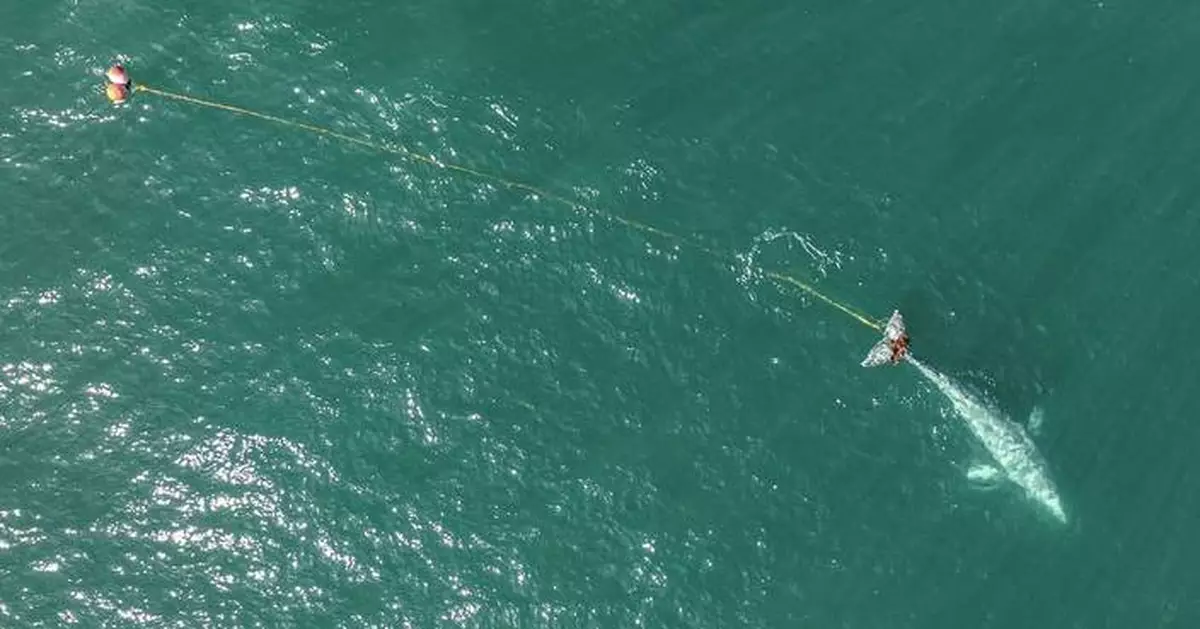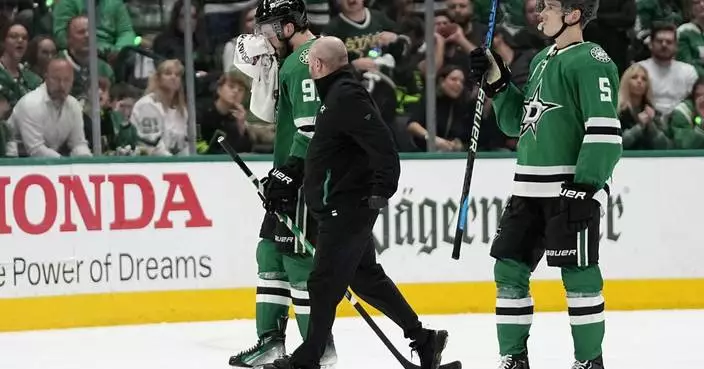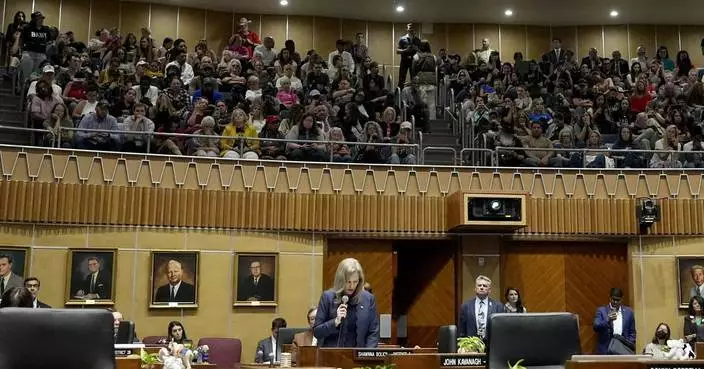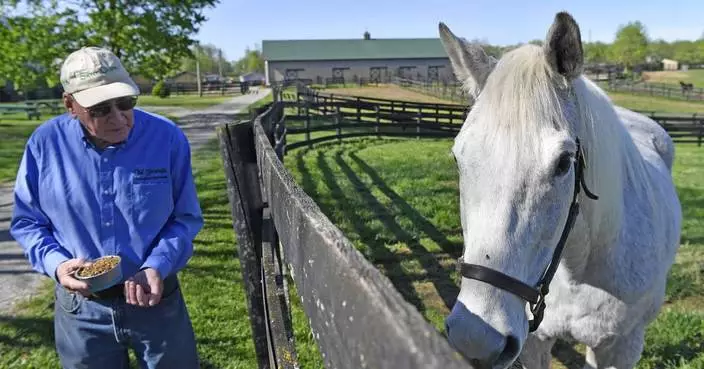SAN FRANCISCO (AP) — Rescuers were searching Wednesday for a gray whale last spotted off Northern California's coast with its tail entangled in a massive gill net.
The 30-foot (9-meter) whale was spotted Tuesday near San Francisco swimming north as part of gray whales' annual migration from Mexico to Alaska. It was dragging the net with two bright red buoys that rescuers attached to it on March 22, when the animal was first spotted off Laguna Beach in Southern California.
Justin Viezbicke, coordinator of the National Oceanic and Atmospheric Administration Fisheries' California marine mammal stranding response, said the rescue team pulled up behind the animal on Tuesday but could not cut the net because it became aggressive.
“The team went out there yesterday and made some attempts but as the team approached, the animal became very reactive,” Viezbicke said.
NOAA's team, which is working on the rescue effort with the Marine Mammal Center in Sausalito, California, was searching Wednesday for the whale north of San Francisco.
Kathi George, director of cetacean conservation biology at the Marine Mammal Center, said a rescue crew in Southern California couldn't disentangle the whale last month but the team was able to attach a satellite tag to the net to track it and two buoys to make it easier to spot the animal. But the tracker is no longer attached, she said.
George said that if the rescue team spots the whale on Wednesday they will attempt to cut the net or at least attach another satellite tag.
"Our goal is to retrieve the gear that’s on the whale, so we can learn more about the entanglement and how it happened so, we could use that to inform risk reduction efforts,” she said.
Every spring, Gray whales migrate 5,000 miles (8,000 kilometers) from birthing waters off Baja California, Mexico to feeding grounds in the Arctic.

In this aerial photo provided by Tony Corso Images, a 30-foot-long gray whale with its tail entangled in a massive gill net is seen off the coast of Pacifica, Calif., Tuesday, April 9, 2024. A team with the National Oceanic and Atmospheric Administration Fisheries is working on a rescue effort Wednesday with the Marine Mammal Center in Sausalito. (Tony Corso Images via AP)
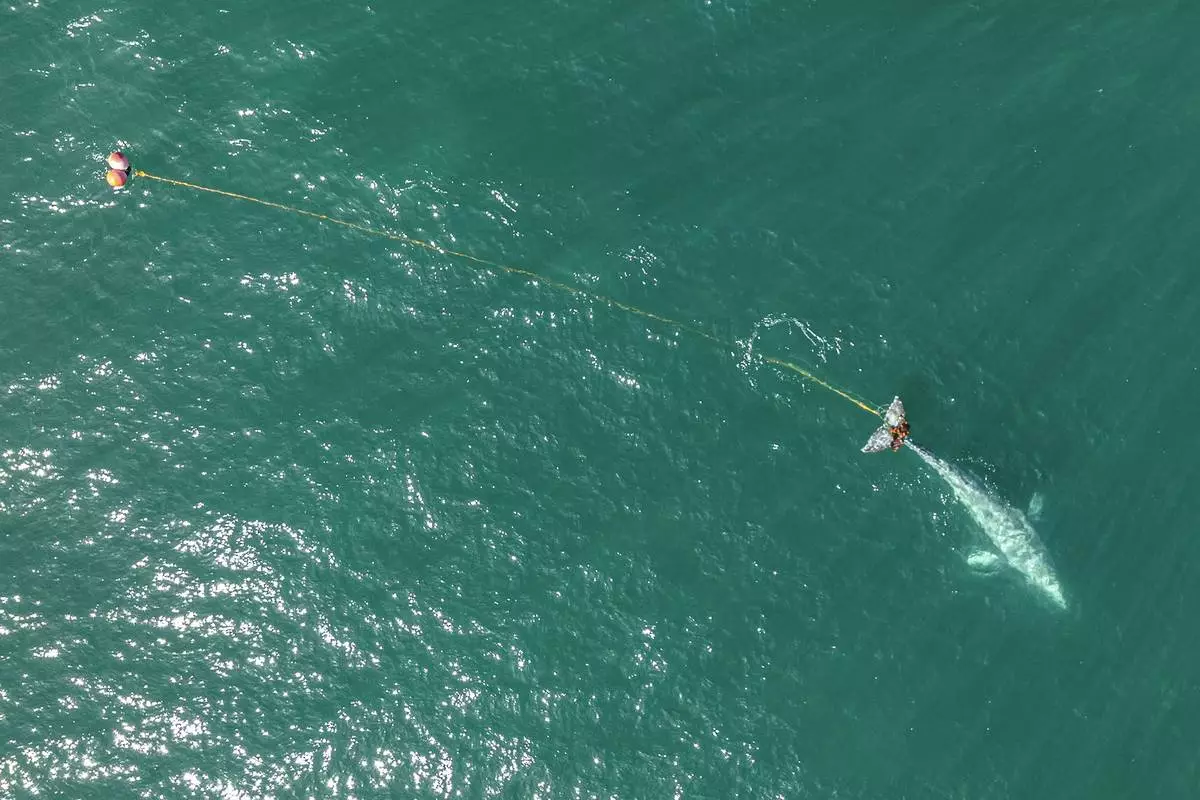
In this aerial photo provided by Tony Corso Images, a 30-foot-long gray whale with its tail entangled in a massive gill net is seen off the coast of Pacifica, Calif., Tuesday, April 9, 2024. A team with the National Oceanic and Atmospheric Administration Fisheries is working on a rescue effort Wednesday with the Marine Mammal Center in Sausalito. (Tony Corso Images via AP)
NEW YORK (AP) — Ordered by police to leave the scene of a UCLA campus protest after violence broke out, Catherine Hamilton and three colleagues from the Daily Bruin suddenly found themselves surrounded by demonstrators who beat, kicked and sprayed them with a noxious chemical.
On American campuses awash in anger this spring, student journalists are in the center of it all, sometimes uncomfortably so. They're immersed in the story in ways journalists for major media organizations often can't be. And they face dual challenges — as members of the media and students at the institutions they are covering.
Across the country from University of California, Los Angeles late Tuesday, a student-run radio station broadcast live as police cleared a building taken by protesters on the Columbia University campus, while other student journalists were confined to dorms and threatened with arrests.
Hamilton's attackers wore masks. But she recognized the voice of one as a counter-demonstrator sympathetic to Israel's cause because of prior reporting when some of them filmed her working and harassed her by name. She checked out of a hospital Wednesday after learning that injuries to her arms and chest were bruises.
“While it was terrifying and, honestly, will take a lot of mental processing, the experience confirmed for me the importance of student journalists because we know our campus better than any outside reporter would," said Hamilton, 21. "It has not deterred me from wanting to continue this coverage.”
Fear and anger were obvious in the voices of students narrating the action on Columbia's WKCR radio on Tuesday. The station's website briefly went down because so many people were listening to an audio stream, and its announcers recommended people tune in to FM radio instead.
Even though he wore a badge identifying him as a member of the press, police ordered Chris Mandell and other reporters for the Columbia Daily Spectator into a dormitory. When he tried to open the door, Mandell said he was told he'd be arrested if he did it again.
Mandell has been covering the demonstrations and the planning for months. While he considers it a learning experience, he said “it has been breaking my heart” to see the police presence on campus and how the story has been covered by outside journalists.
The Daily Spectator has been on the story every step of the way and hasn't hesitated to confront Columbia University's leadership in print. In an editorial late last month, the students sharply condemned university President Minouche Shafik and said administrators have been uncommunicative except for “ominous late-night emails.”
“This is your legacy,” the Spectator wrote — “a president more focused on the brand of your university than the safety of your students and their demands for justice.”
At campuses across the country, around-the-clock reporting from protests and student disciplinary hearings have meant overnight vigils at encampments blurring into morning classes, homework and final projects crammed in between interviews.
Student-run news websites at Yale and the University of Texas-Austin cover the action with innovative live blogs. The Daily Trojan's print editions have stopped for the semester at the University of Southern California, but Editor-in-Chief Anjali Patel tries to keep a reporter and photographer available at all hours to feed its website, post news on X and Instagram and do live streams. All during final exam season.
“We are still students at the end of the day,” Patel said.
At Columbia, whose journalism school is considered one of the country's finest, Dean Jelani Cobb wrote a memo Wednesday to the population of budding journalists who are his students: “You are a part of history now. Your perseverance during a confusing and challenging moment cannot be understated. You told the stories the global public deserved to hear. You helped the school to meet its mission.”
The protest movement has become a training ground for students grappling with complicated editorial decisions for some of the first times in their careers. They confront the awkwardness of reporting on their peers and the challenge not to get swept up in emotion.
“This is a moment in our campus’ history,” said Arianna Smith, editor-in-chief of The Lantern at Ohio State University. “Being able to contribute to its coverage is a privilege we don’t take lightly. We’re under a lot of pressure to get it right, to be accurate, so that’s what we’re striving to do.”
Over three dozen Ohio State University students and demonstrators face misdemeanor charges after a Thursday night crackdown by the university on protests about investments in Israel.
Lantern staff members are having meetings about balancing the experiences of pro-Palestinian protesters and Jewish students or counter-protesters, Smith said. They debate whether to publish the names of students who face discipline, compare language choices to other news organizations and reflect on what viewpoints are missing from stories. Editors instruct reporters to keep opinions to themselves.
At the University of North Carolina at Chapel Hill’s newspaper, The Daily Tar Heel, student journalists are also making difficult decisions about anonymous sourcing. Managing Editor Liv Reilly said photographers are being mindful not to take photos that show faces of people who fear being arrested.
Josie Stewart, managing editor for content at Ohio State's Lantern, said she recognizes classmates on both sides of the protest. The newspaper's coverage is discussed in her classes, and friends are regularly asking her about it.
“It’s definitely difficult,” she said. “Every journalist has to balance ethical concerns, but it is more difficult when you’re staring someone in the face in class.”
Sometimes Reilly feels the instinct to say hello to classmates involved in the protest, but stops. She's worried about saying their names out loud if they fear being identified, and is mindful of the boundaries between classmate and reporter. She makes sure to identify herself as a reporter, but “people’s demeanors sometimes change when you say you’re with the media.”
Annika Sunkara, social media editor for The Huntington News at Boston’s Northeastern University, said it has been emotional talking to fellow students, some in tears, about their experiences with law enforcement. Around 100 people were arrested there Saturday morning when police broke up pro-Palestinian encampments on the campus.
But as national news outlets descend on campuses nationwide, student journalists say their connection to their campuses is their greatest asset. They've built relationships with student groups, faculty and administrators. They follow many of their peers, now turned protest leaders, on social media.
“We’re the ones on the ground seeing what’s happening with our own eyes,” Stewart said. “We have a different level of access, of trust on our campus and of understanding.”
Some universities, including UCLA, have also seen scattered protests and student organizing since October. The Daily Bruin has been there “at every step,” Hamilton said, so the staff “understand the demands of the students, the different perspectives on campus, the stakeholders in a way other news outlets can’t.”
Wearing a Daily Tar Heel hoodie, Reilly watched national news reporters stand in front of cameras for live shots before heading home one recent evening. She sat down with water bottles and blankets, ready for a 14-hour shift.
“This is a monumental piece of history for my generation and my peers,” she said. “And it’s been hard to navigate, to make the right editorial calls, to stay as neutral as possible while also not causing harm to any community. But we are here and we’re learning, and we’re ready to keep covering.”
Bauder reported from New York, Fernando from Chicago. AP journalists Jake Offenhartz and Mallika Sen contributed to this report. The Associated Press receives support from several private foundations to enhance its explanatory coverage of elections and democracy. See more about AP’s democracy initiative here. The AP is solely responsible for all content.

Officers with the New York Police Department arrest pro-Palestinian protesters at Columbia University, Tuesday, April 30, 2024, in New York. The protesters had seized the administration building, known as Hamilton Hall, more than 20 hours earlier in a major escalation as demonstrations against the Israel-Hamas war spread on college campuses nationwide. (Marco Postigo Storel via AP)

Officers with the New York Police Department arrest Pro-Palestinian protesters at Columbia University, Tuesday, April 30, 2024, in New York. The protesters had seized the administration building, known as Hamilton Hall, more than 20 hours earlier in a major escalation as demonstrations against the Israel-Hamas war spread on college campuses nationwide. (Marco Postigo Storel via AP)
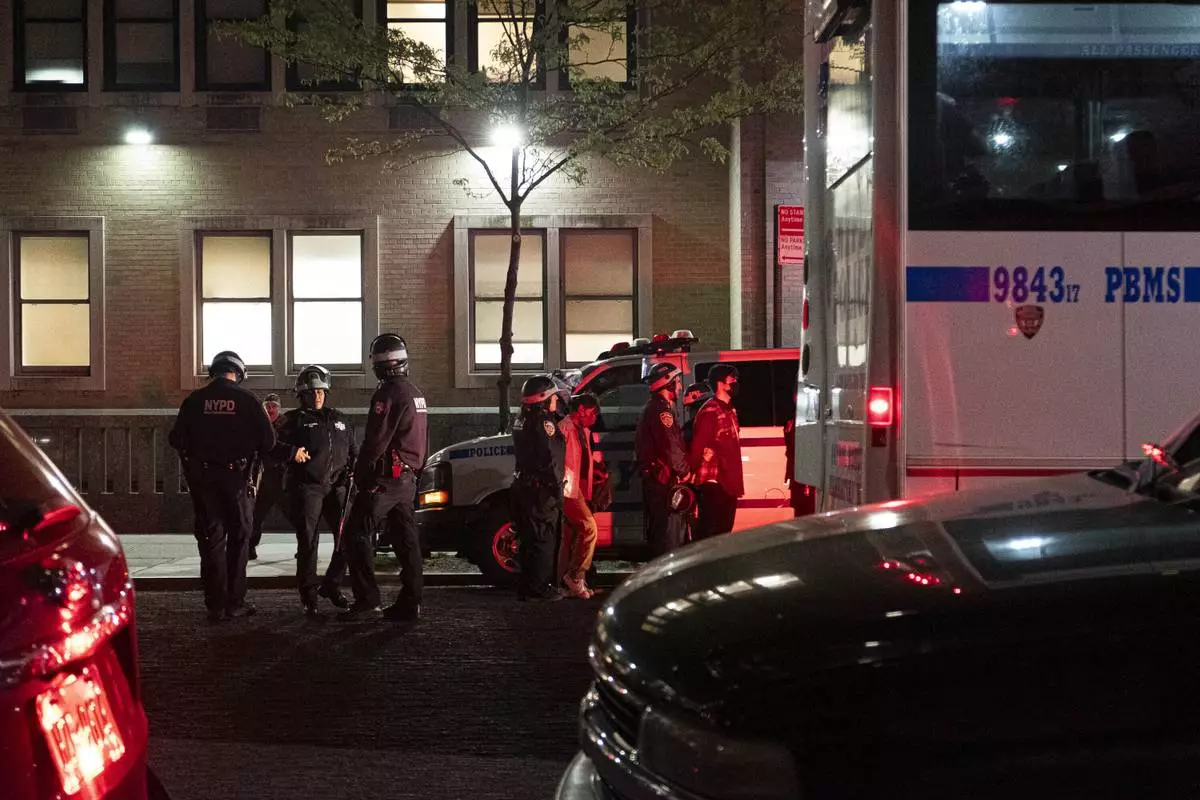
Officers with the New York Police Department stand outside Columbia University's Hamilton Hall as they disperse Pro-Palestine students and protestors occupying Hamilton Hall on Tuesday evening, April 30, 2024 in New York. Members of the occupation took over Hamilton Hall in the early hours of Tuesday morning. (Seyma Bayram via AP)

Officers with the New York Police Department stand outside Columbia University's Hamilton Hall as they disperse Pro-Palestine students and protestors occupying Hamilton Hall on Tuesday evening, April 30, 2024 in New York. Members of the occupation took over Hamilton Hall in the early hours of Tuesday morning. (Seyma Bayram via AP)
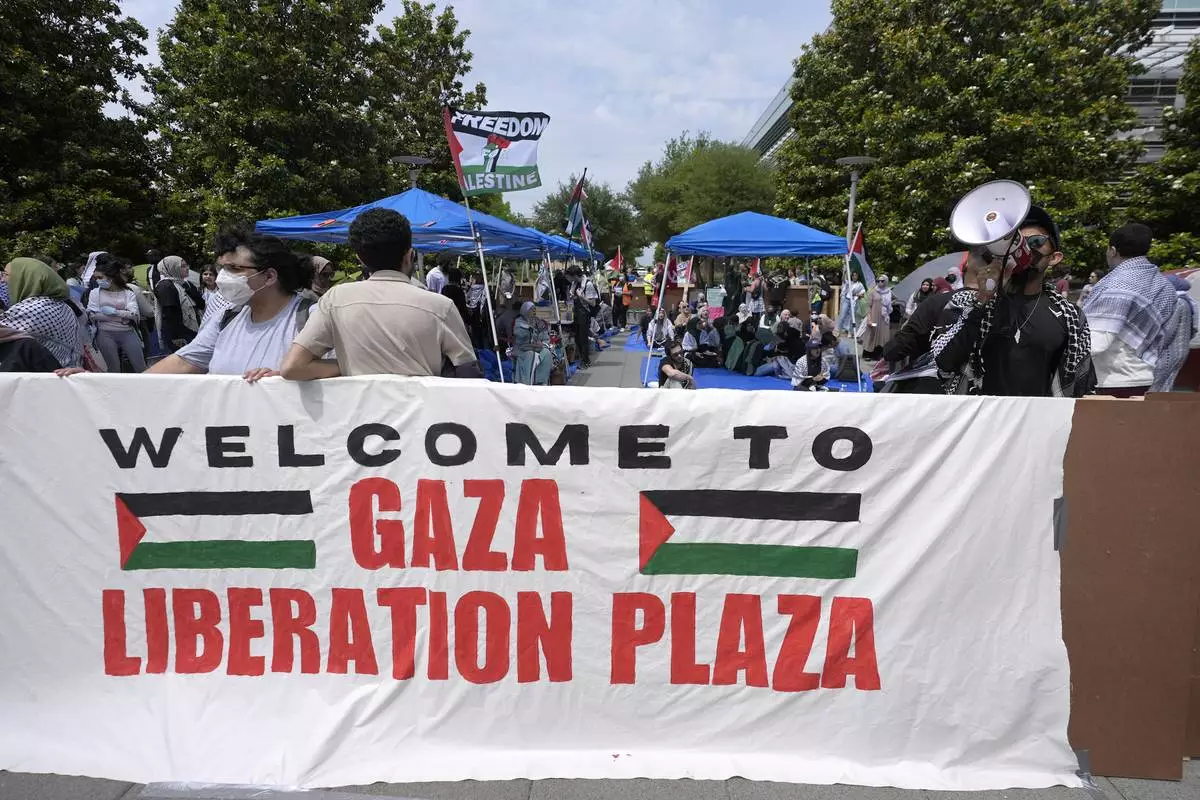
People gather to protest against the Israel-Hamas war at a plaza at the University of Texas at Dallas, Wednesday, May 1, 2024, in Richardson, Texas. (AP Photo/LM Otero)

A man uses a megaphone to chant against the Israel-Hamas war at a protest site set up at the University of Texas at Dallas, Wednesday, May 1, 2024, in Richardson, Texas. (AP Photo/LM Otero)
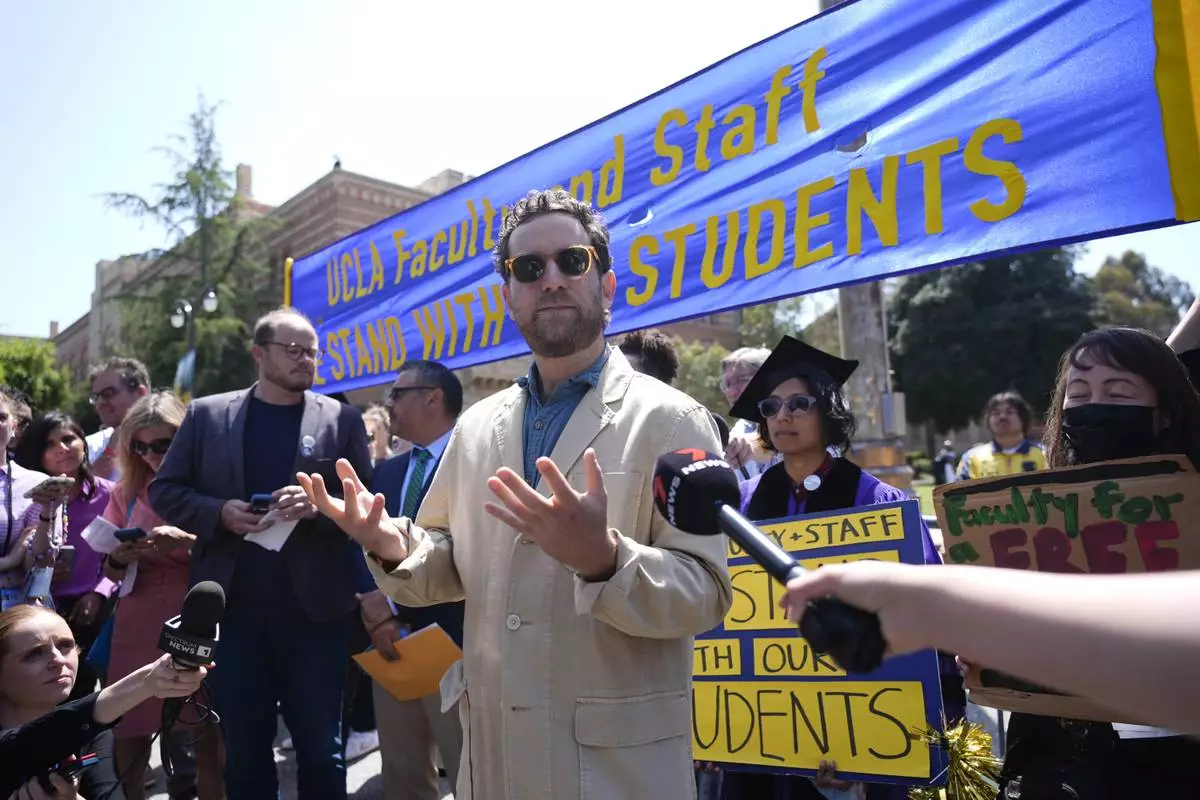
UCLA professor Nick Shapiro speaks at a news conference on the UCLA campus, after nighttime clashes between Pro-Israel and Pro-Palestinian groups, Wednesday, May 1, 2024, in Los Angeles. (AP Photo/Jae C. Hong)

Police pepper spray pro-Palestinian protesters blocking police vehicles from leaving the University of Texas in Austin, Texas, Monday, April 29, 2024. (Aaron E. Martinez/Austin American-Statesman via AP)

Officers with the New York Police Department raid the encampment by pro-Palestinian protesters at Columbia University on Tuesday, April 30, 2024, in New York. The protesters had seized the administration building, known as Hamilton Hall, more than 20 hours earlier in a major escalation as demonstrations against the Israel-Hamas war spread on college campuses nationwide. (Marco Postigo Storel via AP)

Demonstrators clash at a pro-Palestinian encampment at UCLA early Wednesday, May 1, 2024, in Los Angeles. Dueling groups of protesters have clashed at the University of California, Los Angeles, grappling in fistfights and shoving, kicking and using sticks to beat one another. (AP Photo/Ethan Swope)

Student protesters camp near the entrance to Hamilton Hall on the campus of Columbia University, Tuesday, April 30, 2024, in New York. Early Tuesday, dozens of protesters took over Hamilton Hall, locking arms and carrying furniture and metal barricades to the building. Columbia responded by restricting access to campus. (AP Photo/Mary Altaffer, Pool)




